Going in Circles in Myanmar
Article and photos by James
Michael Dorsey
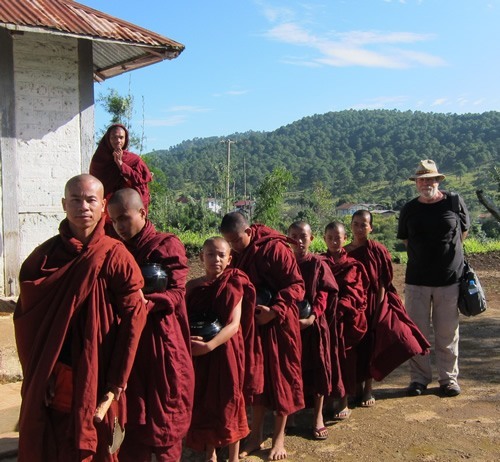
|
|
Buddhist monks in Kalaw, Myanmar.
|
The afternoon monsoon is so intense that I can barely make out the circle train pulling into Yangon central station. It lumbers into the boarding area like an apparition, slowly becoming more visible as it breaks through the curtain of water. Tons of rain water pours off the corrugated awnings, creating massive waterfalls for lines of waiting children to run through, while more than one adult also take advantage of this free, cleansing, public shower.
The train, a relic from the British occupation, wheezes and coughs to a stop. It seems to pant as it sits there like an aging athlete wanting to get into one more game. The interior reeks of colonial Indochina with the hard straight wooden seats and ancient revolving steel fans that rarely work. Drab gray and blue, the blistering paint job was done with WWII leftover materials. Windows locked open allow free entry to the monsoons that cool the cars far more efficiently than the Eisenhower-era fans, but at stops the mosquitoes swarm in the humidity. A tiny ahma (elderly woman), wrapped in the colorful textiles of her hill tribe, climbs up the steps before me followed by two pimply faced young monks, one of whom stubs out his cigarette butt before boarding. I find an empty bench seat but am quickly joined by a diminutive old man with the slightest wisp of a beard who smiles at me through beetle/nut stained teeth, while spitting long brown streams into a paper cup.
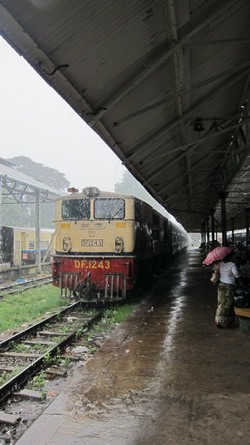
|
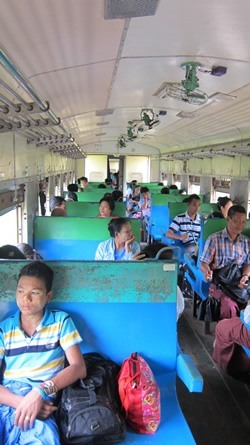
|
|
Circle train in a monsoon.
|
Passengers on the circle train.
|
As the station clock clicks both hands onto twelve high, we lurch forward, feeling the aging couplings straining between cars as the old dowager huffs and puffs along the tracks one more time. When we pick up speed the car begins rocking to and fro as though caught in a major earthquake, throwing those unprepared into the laps of strangers. I am caught wondering about engineers who do not understood the principles of being excessively top-heavy. The train reminds me of camels, the main transport of the world’s great deserts, whose only job is to go back and forth, hauling cargo between two fixed points day in and day out. Once underway the repetitive clickety-clack of steel wheels on similar tracks and the continuous swaying of the cars becomes a kind of mantra, emphasizing the Buddhist devotion to the country.
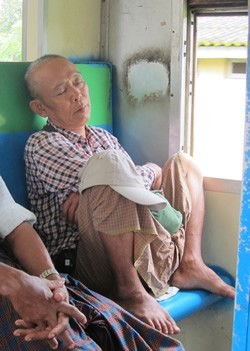
|
|
Man sleeping on the train.
|
The circle train, in the words of its chief station master, Mr. Neien Sanda, “Lets you see all of Burma in three hours." His words turn out to be precisely true. Tickets can only be purchased at the tiny brick house known as platform 7 usually identified by a long line of congregating visitors. Locals and foreigners pay 100-200 Kyat (about 10-20 cents U.S.) for the ride. Just as its name implies, and with an efficiency that would make a Disneyland ride operator jealous, the train makes a complete circle around Yangon. 21 trains run non–stop, pausing at 39 stations along the 46 kilometer line, (28.5 miles) and then return to do it all over again every three hours, come rain or shine. A ticket allows you to get on or off wherever you wish at the stops. Each is a window into a particular neighborhood and local way of life. The ticket is good all day no matter how much time you get off and re-board, so it is both cheaper and more efficient than seeing the city by cab or mini-bike — and far less strenuous.
The train meanders at various speeds through high-rise residential districts, downtown shopping areas, monasteries, street markets, and the lush green rice paddies that border the city. Even a brief stop at any of these venues is a complete immersion in Burmese culture, each with its own unique neighborhood atmosphere. But the joy for this traveler lay always in the people. Local people ride the train to and from work, while the jungle and hill tribe people use the transport to sell their crafts and wares at the various weekend street markets. Students on their way to class, monks setting out to seek morning alms, backpackers, tour groups, as well as anyone interested in meeting locals and having a good time can be found on the train.
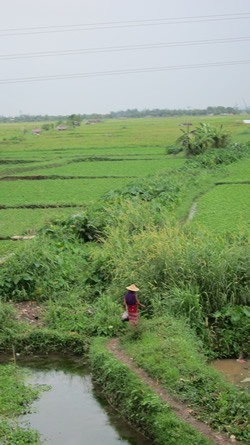
|
|
Rice paddies seen from the train.
|
My seat companion was a noisy young pig in the arms of an aging woman who seemed enthralled to be sitting next to a westerner. She talked through most of our time together, and I never understood a word she said, but it was a most wonderful conversation. I stepped off the train at a street market trying to skip between the deep red beetle juice spittle that forms a never-ending abstract work of art on the ground. I suddenly found myself in 19th century Indochina. Before I knew it I was trying on a headpiece from the central highlands and bargaining over the price. And it should be noted here that bargaining is a way of life in Yangon. A vender would register pure shock should a buyer agree to the initial price of anything on offer. Bargaining is an ancient and respected way of doing business in this part of the world.
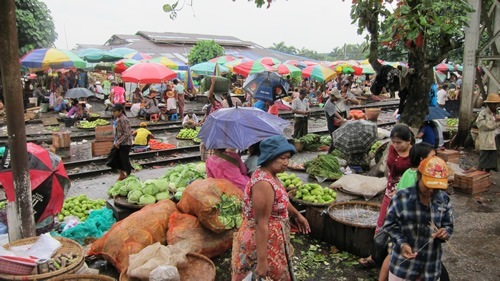
|
|
Street market along the way.
|
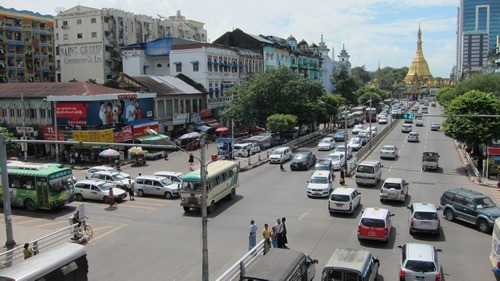
|
|
Downtown Yangon.
|
Near a monastery I photographed monks returning home from collecting the morning’s alms. I was taken both by the range of ages and the reverence shown to the monks. Some were boys no more than seven or eight, and though they wore the religious robes, their behavior on the street revealed the playfulness of young children. Still, regardless of age or behavior, monks command great respect in Myanmar and any juvenile behavior by them is overlooked. At one point, two monks on a motorbike driven by a third person raced us yelling and waving at their brethren aboard the train. For many, the religious path is the only exit from a life of dire poverty and a chance for at least a bit of formal education.
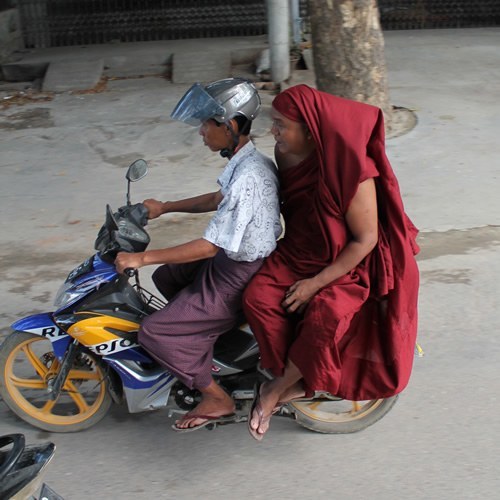
|
|
Monk on a motorbike.
|
Passing into rural areas we watched a pole climb, a popular local sport in which a small bag of coins is placed atop a very slippery telephone pole. Neighborhood teams build human pyramids in order to boost one of their members to the top and snatch the prize. Entire blocks of people turn out to cheer their champions before retiring to a local bar for cold beer.
On the outskirts of the city, vast green rice paddies spread across the horizon, lush from the intermittent monsoons. Steam rises when the rays of the blistering sun strikes the last drops of the morning’s downpour that had covered all vegetation. Wearing straw hats, the backs of laborers rose up and down, appearing and then disappearing, as they bent to pull up the long stalks that feed much of Southeast Asia. Above it all, towering spires of the cities’ golden-domed pagodas poked their summits into the sky. We also passed more than one blue-turreted mosque along the way.
Returning to the city, we passed countless roadside eateries filled with clients, who were both escaping the indoor heat and enjoying the comradery of open-air dining that is a way of life in Burma. From a distance, I can make out the movie marquee touting the latest offering from Bollywood. Through most of the downtown areas bicycles passed us in traffic, but the slow pace of life made people-watching even more enjoyable. At one stop I photographed a tiny grandmother puffing on a cigar with two fingers while holding an ashtray under it with the same hand. All the while, she was rolling beetle nut into green leaves with her free hand. Meanwhile, a long line of pink and orange clad Buddhist nuns passed by her in file on their way to teach classes.
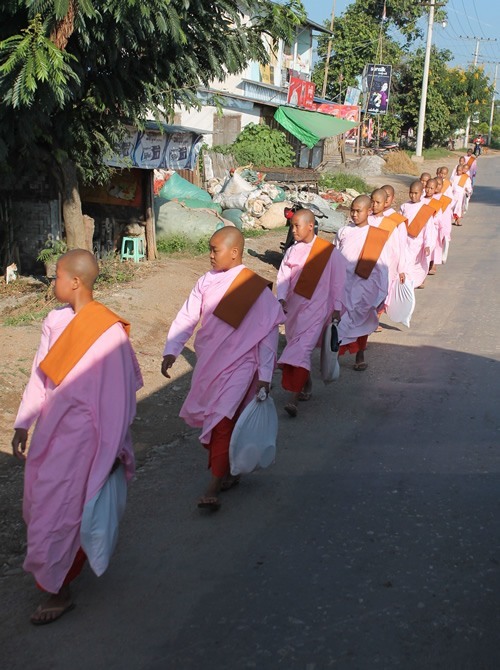
|
|
Nuns walking in file.
|
|
We passed numerous trackside shrines, some private little altars to personal deities, while others honored deceased relatives. At every stop, beautiful young ladies, their faces coated with thamaka — a sunblock made from tree bark and an integral part of Burmese culture — went from window to window hawking fruit, flowers, and gum. Towheaded young boys concentrated on simply asking foreign looking riders to give them money. At every platform, the ubiquitous poster of Aung San Suu Kyi was present. As a winner of the Nobel Peace Prize, daughter of the father of the country, and Myanmar’s most famous political dissident, it is impossible to go anywhere in the country without running into her likeness.
Guidebooks list the circle train as a must-do for those who only have one day in the city. In truth, be it for a day or a month, the train is the easiest and most entertaining way to feel the pulse of Myanmar. When travelers can find ways to immerse themselves into the daily life of local people it is a gift most tourists may never experience, and in Burma the train is the perfect medium.
If You Go: The circle train is located inside the central train station on Kun Chan Road, in Yangon Myanmar. It is several blocks west of the river, and any cab driver or local person will be happy to direct you there.
You cannot purchase tickets at the regular booths, but must go to the center of the station to platform 7, where you will find a tiny little nondescript block house. This is the only place that sells tickets for the circle train.
James Michael Dorsey is
an explorer, award winning author, photographer, and
lecturer. He has traveled extensively in 45 countries,
mostly far off the beaten path. His main pursuit
is visiting remote tribal cultures in Asia
and Africa.
|
